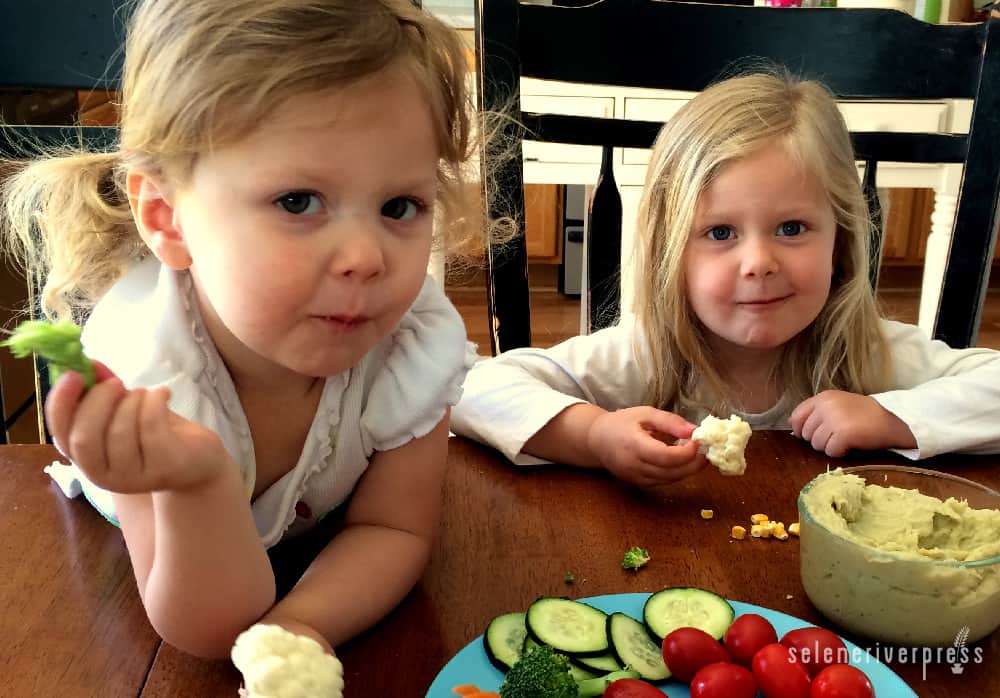Few things are more discouraging than planning a nutritious meal, gathering healthy ingredients, and cooking the wholesome dish for your family—only to be met with a chorus of complaints: “This looks gross!” “What’s that green stuff?” “I hate tomatoes!” And the ultimate, “I’m not eating that.”
Your heart sinks. Your temperature rises a little (or a lot).
Every parent has experienced this mealtime debacle many times over. After all the wasted time, effort, and money, many of us throw in the towel and simply make the food we know our kids will eat, even if it’s boxed macaroni and cheese with hot dogs. Why bother with the healthy food if it’s just going to waste anyway, right? Wrong!
I have a plan to help you avoid the dreaded mealtime battles and enjoy wonderful meals with happy eaters! I’ve done it with my own family—following advice from nutritionists and pediatricians, testing out my own ideas, and implementing the following tried-and-true practices—so I know it works! Now I enjoy preparing meals that are packed with the nutritious power I want for my children. And better yet, they enjoy eating them. Follow these guidelines, and you’ll remedy even your pickiest eaters.
#1. Make Meals for the Whole Family
Don’t distinguish “kid food” and “adult food.” Don’t make your kids’ plates different from your own plate based on what they like or what’s familiar to them. I’ve eaten in far too many households where parents make various versions of dinner according to their kids’ tastes.
Catering in this way only encourages children to be limited in what they’re willing to eat. They also learn to expect others to accommodate their pickiness rather than try new things.
I give my little kids the same salads and loaded, healthy burritos that I eat instead of separate servings of the ingredients they like. They can deconstruct it if they choose, but this gives them the option to eat some new things, and they’re learning their meals won’t be catered to them.
#2. Forget the Kid’s Meals!
The kid’s menu at restaurants is usually the same “kid friendly” stuff you can find anywhere: mac ’n cheese, corn dogs, chicken nuggets, french fries. Then they just add some canned fruit so you feel better about the meal. Kid’s meals also include soda or sugary juice, which makes it harder to get your little tike to drink healthy, pure water.
On the regular menu, you’ll find whole, balanced meals filled with all the food groups, so why not let the kids order from it? There are so many more options! Also, the food on the regular menu is prepared by chefs using a variety of spices and flavors, whereas the items on the kid’s menu are usually the same prepackaged, processed food you find in grocery stores—but double the price.
Perhaps the only reason kids eat the same “kid” foods is because it’s all we offer them! So let them color on the kid’s menu, not order from it. As an added bonus, it’s much less expensive to split regular meals amongst your kids than it is to order individual kid’s meals. Don’t be fooled by the $5 deals—they add up! I do the math each time, and splitting full-size meals saves me big bucks and gives my kids healthier choices. Plus, we can share dishes as a family since we’re all eating the same quality food.
#3. Put Everything on the Plate
I’ve done this since my kids were infants. I don’t change or leave out items based on pickiness. At potlucks and holiday dinners, every healthy dish goes on their plate. If I make a stir-fry with seven different vegetables, I serve them all, even if my kids say they only like two of them. It’s fine if they don’t eat them all. But the more they see them and watch their parents enjoy them, the more they’re encouraged to give those “yucky peas” another try.
We don’t force them to eat any food they dislike—that’s not necessary. We just tell them it’s okay if they don’t like something, but one day they may change their mind. For example, my four-year-old said she hated tomatoes for two whole years. Then one day she said, “Mommy, I like tomatoes now!” And she eats them like crazy. This wouldn’t have happened if I stopped giving her tomatoes with each meal.
And you never know, sometimes it’s just the dish itself rather than a particular vegetable or food. So serve the ingredient in different ways and see what happens. Zucchini made into noodles with a spiralizer and served with pasta sauce or clam linguini might suddenly taste better than sliced zucchini alone.
Which brings up another element for picky eaters: flavor. Food grown on mineral- and microbial-rich soil has more flavor than food grown on depleted soil. So source your food from organic farms and ranches as much as possible.
#4. Don’t Stress Over Missed Meals
Children won’t let themselves starve. They really won’t. And you can’t force them to eat, so don’t try. You only anger yourself trying to control the uncontrollable. If my kids aren’t hungry, that’s okay! If they say they’re full after three bites, fine! They know their bodies, and getting them to eat based on arbitrary rules such as “ten bites,” or excusing them only after they’ve eaten enough off their plate develops the same bad habits in them that we see in the society at large, like emotional eating or following social rules rather than listening to your body’s needs.
However, we do let them know there are no other options for dinner. No making something else to eat. No snacking on junk food an hour later. And even if they aren’t hungry, they still join at the table for family time (and often end up eating). If they don’t eat much, they can eat dinner later. Why not? If you’re hungry after dinner, do you deny yourself and say, “Kitchen’s closed! I have to wait until morning!” Of course not.
I just leave their food out so if they get hungry an hour later, I can offer their dinner, nothing else. I’m not dictating when and how much they eat, but I am teaching them that skipping dinner doesn’t mean filling up on junk later. Knowing this, more often than not they simply eat when the food is hot.
However, if your family is transitioning to a healthier diet, your kids will fight it. They may even choose to miss quite a few meals in a row. Hang in there! You’re not starving your kids by offering them a plethora of healthy foods! But you will starve them nutritionally if you revert to unhealthy foods just to please them. So stay the course!
#5. It’s Fine If They Don’t Like Certain Foods
There are foods I don’t like, and I choose not to eat them. Why would my kids be any different? If they say they hate peppers, I tell them that’s okay. But I also explain that they may like peppers some day, so I’ll keep putting them on the plate just in case.
We do have a rule that they must try everything once before they can say they don’t like it. We don’t do this to be harsh, but we explain they can’t know if they like something or not before they try it. And when we try something new and like it, we make a big deal out of it, so our kids also get excited about liking new foods.
If you have little ones, watching familiar shows or reading books about trying new food should be a huge help! For example, just think of the surprising conclusion to Dr. Seuss’s Green Eggs and Ham. After all his fussing, the man finally realizes he does like it after he tries it. When we remind our children of this story, they’re always more inclined to follow suit and say, “I do like it!” Trust me, this works wonders!
Check back here next week for the second installment of my series, “How to Cure Picky Eaters, Part Two.”
Related Topics
childhood nutrition | holistic nutrition | organic food | whole food nutrition
 Get self-health education, nutrition resources, and a FREE copy of A Terrible Ten: Health Foods That Ain't ebook.
Get self-health education, nutrition resources, and a FREE copy of A Terrible Ten: Health Foods That Ain't ebook.
